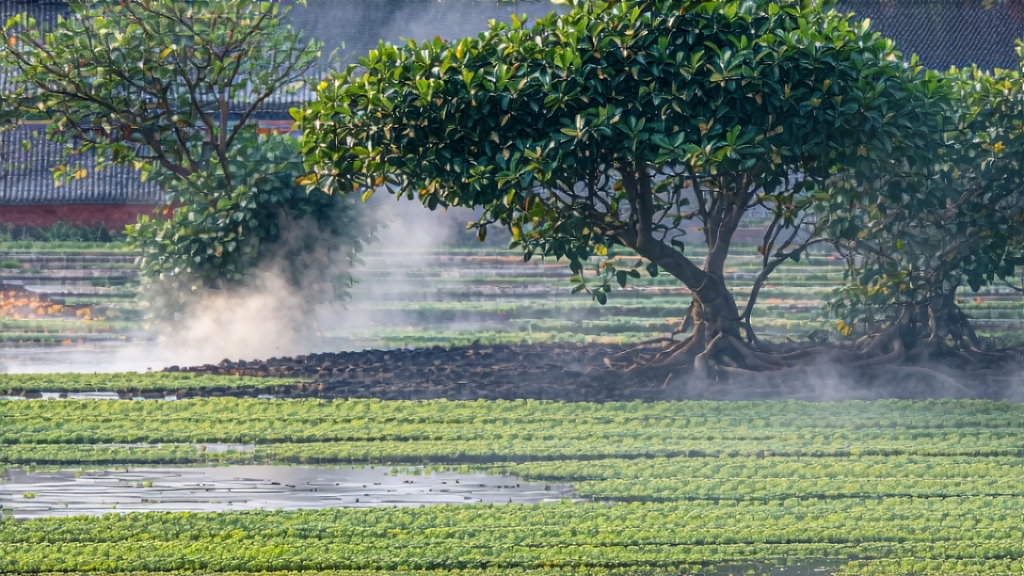
If green tea is China’s gentle watercolor and pu-erh its aged ink wash, then Phoenix Dancong is the country’s lingering flute solo—clear, aromatic, and capable of evoking whole landscapes in a single breath. Nestled in the granite spine of Phoenix Mountain (Fenghuang Shan) in northern Guangdong, this remarkable oolong has been seducing tea traders, poets, and now global gourmets for almost a millennium. Unlike the garden-style hedges that carpet most tea regions, Dancong trees stand tall and gnarled, often exceeding three meters in height, their roots plunging into mineral-rich slopes between 350 m and 1,400 m. Locals insist that the mountain’s diurnal temperature swings, lingering sea humidity, and 200-plus aromatic plant species perfume the leaf through invisible botanical conversation. Whatever the science, the cup delivers: a silky liquor that can mimic peach blossom, almond milk, gardenia, or even fresh ginger depending on the cultivar and craft.
History whispers that Song-dynasty imperial exam candidates once chewed the leaves for mental clarity, giving rise to the name “Song Zhong.” By the late Ming, Dancong had graduated from frontier herb to tribute tea, carried on porters’ backs along the Mei Pass to the courts of Beijing. The 19th-century Chaozhou merchants who pioneered the maritime tea routes shipped “Feng Huang Cha” to Southeast Asia, where it became the morning ritual of gold miners and rubber tappers who still swear by its ability to cut through coconut-cream breakfasts. Today, the Phoenix Mountain Administrative Region lists 3,700 ancient trees aged over 100 years, with nine “mother trees” older than 600—living monuments protected by law and insured for sums higher than most family cars.
The taxonomy of Dancong is a fragrant maze. “Dancong” literally means “single bush,” a nod to the traditional practice of keeping each old tree genetically separate to preserve its unique scent profile. Over centuries, farmers identified and named more than 80 aromatic “sub-varieties,” of which the ten “famous fragrances” dominate the market. Huangzhi Xiang smells like toasted yam; Yulan Xiang recalls magnolia; Milan Xiang drips with honeyed orchid; Zhilan Xiang suggests iris and cream. The most prestigious, Song Zhong, is harvested from direct descendants of those Song-era mother trees and fetches prices rivaling Burgundy grand crus. Modern clonal plantings now supplement ancient stock, yet connoisseurs still speak in hushed tones of “laocong” (old-bush) versus “shucong” (tree-bush), the former prized for deeper mineral length and throat-cooling “shanshui yun” (mountain-water rhyme).
Crafting Phoenix Dancong is a choreography of stress and rest. Picking begins at dawn when dew still pearls the leaf; only the top three or four leaves are taken, because the mature cell walls develop the precursors that will later translate into fruit and flower notes. The pluck is spread on bamboo trays and withered under gentle sun for twenty minutes—just long enough for the edges to lose their brittleness—then moved indoors to oxidize atop reed racks. Here the tea master’s hand enters, shaking the trays every half hour to bruise the margins while keeping the veins intact. Oxidation is arrested at 25–30 %, lower than Wuyi rock teas but higher than Tieguanyin, preserving green vitality while coaxing amber aromatics. Next comes the most photogenic stage: charcoal basket baking. Using embers of local longan or lychee wood, the tea is baked in paper-lined bamboo baskets for six to ten hours across two nights, with cooling intervals that allow the leaf to “breathe.” The baker judges heat by cheek-skin sensation, adding ash or blowing gently to modulate. Finally, the leaf is rested for a month so residual fire recedes and the fragrance stabilizes—patience that separates good Dancong from great.
Western drinkers often brew Dancong like an Assam and wonder why it turns bitter. The Chaozhou gongfu method, by contrast, treats the leaf as a living soloist. Start with a 120 ml gaiwan or small Yixing teapot; pre-heat with just-boiled water, then fill one-third with leaf—yes, it looks extravagant. The first infusion,